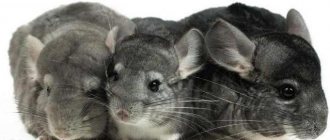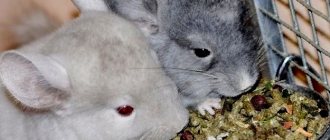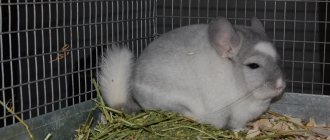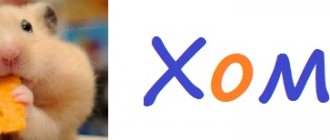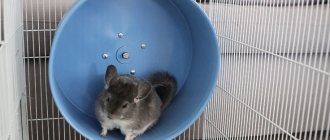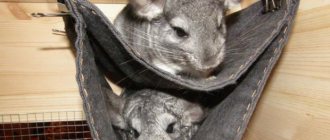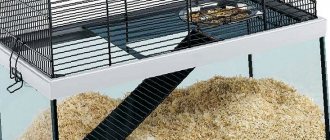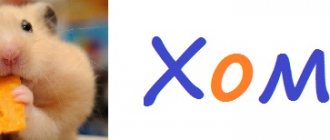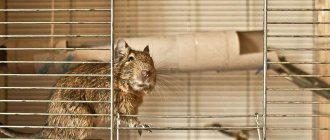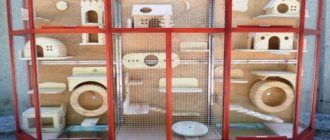A chinchilla cage in a pet store is quite expensive for you to think about making it yourself. And finding a product that is suitable in all respects is quite difficult. By working on your own, you can not only save a lot of money, but also make an enclosure that is significantly superior in functionality to factory-made analogues. First you need to figure out what kind of cage is needed for a chinchilla, and then decide on the materials and its internal contents.
Features of a chinchilla cage
On sale you can find various options for cages and specialized display cases for chinchillas. They all have a number of differences between themselves.
Dimensions
A chinchilla cannot be called a calm animal, so in order for the animal to be active, it is necessary to choose the right cage size . There should be enough space for the animal to run and jump freely. The minimum cage sizes for keeping different numbers of animals will be as follows:
- for one chinchilla - 80x65x50 cm;
- for a pair of chinchillas - 90x90x50 cm;
- several animals - 100x70x50 cm.
If several chinchillas are kept, then composite structures are created for the animals. This allows the animals to be seated at the right time.
Materials
Galvanized mesh and metal are used in the production of cages. Trays in cages and additional accessories (drinkers, feeders) are made of plastic, as it is less susceptible to moisture. Various protruding parts should be avoided, as the animal can gnaw them, and this often becomes the cause of various diseases.
IMPORTANT! There should be no painted or varnished parts in the chinchilla's house.
Shelves made of plastic with metal edging are very convenient to use, they are easy to clean and last a long time. But if the plastic is slippery and smooth, then the animal may get injured. It is better to give preference to rough surfaces made of natural materials.
It is also worth paying attention to the bars in the cage. The distance between them should not be more than 2.5 cm, otherwise the chinchilla may damage its paws while moving around the cage. For females with offspring, this distance should be even smaller - 1.5 cm. The rods should not be too thin, the permissible width is 1.5 mm.
In addition to cages, chinchilla owners often choose special display cases as a home for the animal. They are made of wood and plexiglass. Such materials are safer for chinchillas, but caring for them poses a number of difficulties.
Wood, unlike plastic and metal, quickly absorbs odors and cannot be disinfected. However, chinchillas are very fond of wooden houses; they can sharpen their teeth on wood.
IMPORTANT! The display case cannot be made from coniferous trees.
Many modern display cases for chinchillas are made of plexiglass with an aluminum frame. For such houses, sheets of plexiglass with a width of 6 mm or more are used; the edges must be processed so that the animal does not get hurt.
Cells can be disassembled or intact
Design
By design, chinchilla cages can be dismountable or solid. The main advantages of collapsible cages are as follows:
- they are easy to transport;
- convenient to store;
- just carry out disinfection.
The main disadvantage is that all the constituent elements of the cage are not tightly fixed to each other, unlike a solid structure. Because of this, a loud noise is heard when the chinchilla is active.
Many models are equipped with a retractable tray, which makes cleaning much easier. Often such pallets are covered on top with a second mesh bottom. The garbage immediately passes through the mesh and ends up in the tray, but the animal can get its paws stuck in such a mesh and get injured trying to get out of it.
Cages equipped with wheels are very convenient to use. Debris regularly appears around the cage and cleaning will require constant moving of the cage. It is much more convenient to do this on wheels, but you need to take care of the stability of the structure.
Showcases take up more space than cages, but have good sound insulation.
IMPORTANT! When purchasing a display case or having it custom-made, you need to ensure there is good ventilation and easy access to the inside for cleaning.
Which house is better?
Town
Chinchillas are animals prone to obesity, and they need active movement just like food and water. You can make chinchillas move by building them easy-to-climb routes in the “town.”
The town includes:
- running wheel for chinchillas;
- shelves fixed at different levels;
- transitions between shelves.
The variety of transitions is limited only by the imagination and skill of the chinchilla owner.
It can be:
- suspension bridges;
- tunnels;
- stairs;
- swing.
The only requirement for all these products is natural wood without paint or varnish. You can make transitions from unsanded branches of edible tree species. And change it periodically.
The role of a transition, a toy and a place to rest is simultaneously performed by a hammock for a chinchilla suspended in a display case. It is made from dense non-stretch fabric. Denim suits well. They secure it so that the chinchilla can jump into the hammock, but cannot swing it too much.
In addition to shelves and passages, the town must have a running wheel and a treadmill. The wheels are sold in pet stores and are designed for all active small animals. You need to buy a wooden or plastic one, as a metal wheel can be dangerous for a chinchilla. But you can do it yourself.
DIY chinchilla wheel
To make a wheel you will need:
- 2 sheets of plywood with a side of at least 40 cm and a thickness of at least 1 cm;
- up to 10 figured meter slats;
- automobile tension bearing;
- drill;
- drill 12 mm;
- self-tapping screws;
- 2 bolts with a diameter of 12 mm: long and short;
- screwdriver;
- washers for bolts;
- nuts for bolts;
- jigsaw
Manufacturing technology:
- Find the middle in the pieces of plywood and drill holes. Using a jigsaw, cut out 2 circles of 30 cm in diameter.
- One is left, another circle with a diameter of 25–27 cm is cut out of the other. Only a large circle will be needed from this circle.
- The slats are cut into pieces about 15 cm long. The size of the slats depends on the chinchilla. The animal must fit freely into the wheel.
- The cut slats are attached closely to the ends of the circle and the cut out circle.
- Put a washer on the long bolt, insert the bolt from the inside into the wheel, put on another washer and screw the structure with a nut.
- A hole for a bolt is drilled in the wall of the display case.
- The center of the bearing is aligned with the hole in the wall and the bearing is screwed in with self-tapping screws.
- The wheel with the bolt is inserted into the bearing and tightened with a nut from the outside of the display case.
The video shows in sufficient detail how to make a running wheel for chinchillas.
Treadmill
For chinchillas, this is an additional device, and it is easier to buy it in a store. There it can be sold as a treadmill for decorative hedgehogs. She looks like this.
Now the display case contains everything necessary for a happy life for chinchillas. All that remains is to figure out what a walking ball is.
Chinchilla ball
This is a device that a chinchilla should not have. The plastic ball transmits infrared rays very well and heats up from the inside. Chinchillas do not tolerate heat well. Half an hour in such a ball is enough for the animal to die.
In such a ball, some careless owners of small animals let them “walk” in the fresh air and eat the green grass that falls into the cracks of the ball. Juicy food is contraindicated for chinchillas. And the stress of a walk is much more harmful than being in a spacious display case.
Which “home” is better for a chinchilla – a cage or a display case?
It doesn’t matter much to the animal whether the walls of the home are made of wire or solid. The main thing is sufficient space and safety.
When choosing a house, you also need to take into account the conditions in the apartment or house itself. So, you should give preference to a showcase if:
- there is enough space for its installation;
- the windows or doors in the room are poorly insulated, and therefore there are drafts;
- there are other animals in the house that do not live in cages;
- people with allergies or small children will live with the chinchilla;
- no plans to move.
If a chinchilla is purchased for breeding and the number of animals will increase in the future, then it is better to purchase a set of cages. They can be combined and, if necessary, installed separately from each other.
How much does a chinchilla cage cost?
The price of the cage depends on the quality of materials used, size and configuration. Of course, the cost also depends on the manufacturer. Products from popular brands will cost more. Thus, the price of budget options starts from 3,000 rubles, more comfortable and equipped housing for a chinchilla costs an average of about 7,500 rubles, and spacious options from popular brands will cost an average of 12,000 rubles.
Below is a table of commercially available chinchilla cages.
| Brand name | Cell characteristics | Price |
| Ferplast | The Ferplast Cincilla Kd cage is equipped with plastic shelves, a drinking bowl, a feeder and a house. Dimensions 80x50x80 cm. | From 16,500 rub. The price for large cages starts from 22,000 rubles |
| For | Fedro Natura cage. The set includes ladders and shelves made of wood, as well as a drinking bowl and feeder. Size 66x45x76 cm. | Price 6500 rub. A similar model with a height of 121 cm costs 13,500 rubles. |
| Credo | Two-door model made of thick plastic and galvanized mesh. Equipped with shelves and ladder. Size 64x44x93 cm. | Price 6500-7500 rub. |
| Triol | The model with parameters 61x46x45 cm is equipped with two doors. There is 1 plastic shelf inside. | Price from 3,900 rub. |
Have you decided to buy a ready-made cage or will you make it yourself?
Making a running wheel
You can make a toy for your pet yourself. Typically, homemade models are made of wood: the material is environmentally friendly, affordable and allows you to make a wheel of the required size. Even taking into account the fact that the animals will gnaw the wood, this version of the wheel is in many ways more economical than buying it. If desired, you can sheathe the outside of the wooden case with metal - this will extend the life of the running wheel.
For production you need:
- A sheet of plywood, no more than a centimeter thick,
- Electric jigsaw,
- Drill,
- Bearing or tensioner for an engine from any car,
- Self-tapping screws,
- Screws,
- Bolt,
- Small planks, three centimeters wide and about fifteen centimeters long.
In order to cut an even circle, first cut a small hole in the center of the plywood sheet with a jigsaw. The required radius is measured from its center. The jigsaw is bolted to the table through the hole made. During cutting, the plywood is rotated around its axis along the intended circle. The result is an even circle of the required diameter.
Next, you should cut out a ring with a similar outer diameter. The planks are fastened inside the wooden ring with thin self-tapping screws. You should first drill the holes with a drill and a 1.5 mm drill bit - this will protect against cracking. The ring is attached to the outside of the resulting plywood circle to give greater strength.
The next step is the rotation unit and fastening. For fastening, a bolt of at least fifteen centimeters long is used. A steel washer with a diameter larger than the bolt is placed on the bolt (so that it does not press into the plywood). The bolt is inserted inside the resulting structure and secured on the outside with a similar washer. A tensioner is put on the bolt and secured with self-tapping screws to a wooden plank. Advantage - the plastic tensioner cage does not produce noise when rotating. The toy is ready!
There are two ways to install a toy in a cage. The entire structure can be attached to a wooden plank or plank using one or two self-tapping screws and installed on the floor of the cage. The board should be wide enough - at least 10 cm. Otherwise, the animal will easily turn the toy over. In the second method, the bar to which the tensioner is screwed is secured with wire to the cage wall. This option is more convenient - the toy is attached more securely and even very active rodents cannot turn it over or move it.
Chinchillas are very active animals. Nature has designed it in such a way that they need to constantly move.
. In order to add variety to a pet's life, many owners try to equip the cage with all kinds of toys.
If a chinchilla lives in a small cage where there is no opportunity to move a lot, then it must have a running wheel. With its help, the animal will be able to maintain physical activity.
The sizes of running wheels should be selected taking into account the age and size of the chinchilla. Pet stores offer a simulator with various diameters - from 28 to 45 cm. The manufacturing material can be:
- metal;
- plastic;
- tree.
Wooden
The average cost of a custom wheel is 4,000 rubles
. They are mainly installed in display cages. A distinctive feature is their noiselessness. But they have certain disadvantages:
- chinchillas chew wooden parts, thereby disabling the exercise machine;
- the animal can make a toilet in the wheel, which will also ruin the structure.
Plastic
These simulators have a number of advantages:
- chinchillas have no desire to chew plastic;
- compact design;
- easy to clean and disinfect
; - has a low price - in the store you can find wheels from 200 rubles for small chinchillas and up to 3000 rubles for an adult.
Metal
Very durable structures, resistant to rodent teeth. They are easy to disassemble and disinfect. Pet stores offer two types of simulators:
- with a fine notch;
- with parallel bars.
Wheels, the base of which is made in the form of a fine notch, will protect the animal from the possibility of injury
. The paws do not fall into small holes; you can stop the movement at any time. If desired, the inner surface of the exercise machine can be protected by covering it with soft fabric.
The cost of such toys varies from 300 to 1500 rubles.
Treadmills for running
A track will be an excellent alternative to a wheel. There are two options: aluminum and plastic. They are safer for the chinchilla's health, as they do not overload the spine. Absolutely silent and do not threaten the animal with injury.
DIY chinchilla cage at home
It is not at all necessary to buy a ready-made house for a chinchilla. You can build it yourself, which will not require large financial costs.
Materials and tools
For manufacturing you will need the following materials:
- steel mesh with a small gap between the rods;
- metal tubes or corners;
- metal sheet for making the bottom;
- hinges and several locks;
- screws, screws, nuts;
- hacksaw for metal (grinder, if available);
- welding machine.
You will also need a drawing of the future house. You can use options from the Internet, where experienced chinchilla breeders share their work, or you can prepare your own project.
Instructions for making a chinchilla cage at home with your own hands
So, step-by-step instructions for making a cage for a chinchilla will be as follows:
- Assembling the cell frame. To do this, you need to cut the metal tubes to the required size and fasten them together using angles and screws.
- A metal bottom is welded to the bottom of the frame. Boards or a sheet of plywood are laid on top of the metal sheet.
- Sheets are cut out of the mesh in a size corresponding to the size of the frame, and then attached to the tubes also using angles and screws.
- A roof is installed on top of the cage walls. It needs to be removable so that you can easily access the inside for cleaning. To make the roof you will need a metal frame and mesh. It is better to use special hinges with a lock as a lock.
IMPORTANT! The bottom of the cage cannot be made only of wood, as the chinchilla can over time completely gnaw through it and run away. It is impossible to leave metal alone because of the appearance of rust on it from moisture.
The house should have a lot of accessories
Requirements
Regardless of whether the chinchilla cage is purchased ready-made or made independently, it must meet certain standards. This will provide the pet with proper living conditions in the future. Housing should not only be comfortably decorated, dry, bright, illuminated, but also have good ventilation.
In addition, several characteristics are important for the design
Minimum size
Keeping an adult chinchilla requires a lot of space: the dimensions of the cage should not be less than 50 cm in length and width and 70 cm in height. If the cage is small, the animal’s activity will decrease and it will begin to get sick more often.
To keep several individuals, the above parameters must be multiplied by the number of animals.
This size will be quite enough for the pet to have a place to rest, eat and play.
Distance between mesh bars
To protect the animal, this figure should be no more than 20 mm. Otherwise, the “fluffies” will be able to easily get out.
Free access for cleaning
To facilitate the process of cleaning the house, the presence of a retractable tray in the design, where you can pour small shavings or sawdust, will help. If you purchase a cage with a fixed floor, then cleaning it will be difficult and inconvenient.
Today, cages for chinchillas are presented in a huge assortment, and each type differs not only in size, design, but also in price. Several cage designs are best suited for keeping this type of animal.
Showcase
It is made in large sizes and is intended for group breeding of pets. As a rule, such models are purchased by those who plan to professionally breed chinchillas. Showcases are made from various materials, but wooden construction is in particular demand.
A cage made of wood is considered environmentally friendly and looks attractive, but it must be additionally lined with dense material, otherwise pets will quickly gnaw through the walls of the structure. You can also make display cases from durable plywood and glass.
Box of twigs
This is a common type of cage that can be found in every pet store at an affordable price. Additionally, the boxes are equipped with houses, which allows you to save money on arranging housing for the animal. Such cages can be disassembled into separate parts, they are convenient to store and transport in bags. In addition, the boxes are easy to clean. The only drawback of such models is that products made from rods are not able to absorb sound.
DIY design
It can be multi-tiered, three-story, corner and wall. For more convenient operation, owners make structures on wheels using old cabinets and chests of drawers. The main advantage of such a house is that it can be assembled from any available material according to an individual design.
Most often, homemade structures are made from plywood, planks and glass, but their assembly requires some experience and time.
What should be in a chinchilla's cage?
One cage is not enough for the animal to live comfortably. The house needs to be equipped with various accessories.
Drinking bowl
The animal must always have access to clean water. A drinking bowl must be placed in the house. It is better to attach it to the wall or door of the cage. There is no need to place it on the floor, as a chinchilla can easily turn it over and there will always be debris in the water. Drinkers can be nipple or ball, you can choose according to the animal’s preference, the main thing is that it does not leak.
Feeder
Feeders are usually made of plastic. It is better to choose a deeper option, but the animal should be comfortable using it. Like the drinking bowl, it is better to attach the feeder to the wall of the house so that all the contents do not end up on the floor. The feeder must be washed regularly.
Sennitsa
You should definitely include hay in your chinchilla's diet. To prevent it from being scattered throughout the cage, it can be placed in a special feeder. Pet stores sell these for chinchillas, but in practice they are not very convenient. It is better to purchase a closed running ring for hamsters for this, but it will also need to be secured in the cage.
Cabin or hammock
If the size of the cage allows, then a special house should be built for the chinchilla; hammocks are very common. If the cage is small or the animal does not like to rest in the house, then it should have special shelves where it can fit. You should choose options with a width of at least 15 cm, since chinchillas rest stretched out to their full height.
Mineral stone
To prevent the chinchilla from sharpening its teeth on the wooden elements of the cage, you should purchase a special mineral stone. It must be installed in full view of the animal, attached to the cage.
Bathing suit
The animals bathe in a non-standard way; they do it in the sand. Therefore, there should be a small container with sand in the house. It should be comfortable for the animal to roll over in it, and to prevent it from knocking it over, the bath should be secured.
Toilet
To maintain cleanliness in the cage, you should install a tray for the animal. Chinchillas are very clean, so there will be no problems using it.
Game Zone
Chinchillas lead a very active lifestyle and are very playful. If the size of the house allows, you need to place more different toys so that the animal does not get bored.
Stairs and suspension bridges
Climbing ladders and bridges do not have to be purchased; you can make them yourself from branches of different thicknesses. Twigs from willow, birch, poplar, and rowan are best suited. Toys will also be a treat for the animal.
Wheel
It is better to buy a plastic wheel that is attached to the wall of the cage, or make it yourself from wood. Metal ones can easily injure the animal.
Toys
Also in the house you can place small plastic tunnels, hammocks, and swings. The main condition is that all toys must be safe for the animal.
It is not necessary to add filler, but it is highly recommended
Maintenance and feeding
Soviet breeders who created the domestic version of the breed tried not only to increase the weight of the animals, but also to make them less demanding in terms of keeping and feeding conditions. Let us note that they succeeded. Farmers raising chinchilla rabbits must follow several basic rules in their care:
- regularly clean cages and change bedding promptly;
- provide a balanced diet, strictly adhere to the feeding schedule;
- provide round-the-clock access to fresh drinking water (in the cold season it should be slightly heated);
- during warm periods, shade cells from direct sunlight;
- protect animals from drafts and strong winds.
Representatives of the breed are unpretentious to living conditions and, with proper care, can spend the winter in cages outside.
Thanks to the very thick undercoat, these rabbits can be kept in cages located outside even in frosty conditions. But to maintain productivity in such conditions, the calorie content of the animals’ daily diet will have to be increased by 20%.
Note that during commercial breeding, Soviet chinchillas are kept in mechanized rabbitries or sheds. In a private backyard, it is quite possible to use ordinary cages. But raising these animals in pits is not recommended
Their fur is highly prized and it is important to keep it clean at all times. It is almost impossible to achieve this with pitting maintenance.
Various vegetables help to diversify and enrich the diet of rabbits
When it comes to feeding these rabbits, everything is quite simple - the daily diet does not include any non-standard products. During the warm period, animals must be provided with fresh grass. Hay is recommended not only in winter, but also as a top dressing in summer. The animals eat grains, mixed feed, and fresh vegetables well. Please note that potatoes can only be offered to them boiled. The diet of chinchillas should include meat and bone or fish meal and vitamin and mineral supplements. From time to time, rabbits should be given young branches of bushes and trees.
In the following video, an experienced rabbit breeder talks about the features of keeping and advantages of the breed:
Cage Filling Options
It is not necessary to add litter to the cage, but it is advisable. This will allow you to better maintain cleanliness and will not lead to an unpleasant odor. Fillers come in the following types:
- woody;
- straw;
- sawdust;
- corn;
- toilet paper.
It is better to give preference to corn or wood filler; they absorb odors best. To save money, you can use straw or regular toilet paper.
IMPORTANT! It is forbidden to use pine filler, since the resin of pine trees is dangerous to the life of the chinchilla.
Main varieties
When looking for a home for your pet, you can find different variations of cages. They differ in appearance, price and quality.
Let's look at the most common options.
From metal rods
This is the most common and very budget option. At the bottom of such a cage there is usually a tray with sawdust, which is easy to clean. It is easy to attach the necessary accessories for your pet to the mesh. But this design does not dampen noise at all; any movement in it will make sound.
Display cage
The material usually used is wood, although other models are also available. Such a cage is a real work of art and the pet becomes part of this composition. It will easily fit into the interior and complement it.
From old furniture
Masters can give a second life to any item. Unnecessary furniture in their hands turns into a beautiful display cage.
For breeding chinchillas
This design is a metal cage divided into several sections, each of which houses a pet.
Where to put a chinchilla's cage?
Not only the comfort, but also the health of the animal depends on where the cage is installed. So, when choosing a place, you should use the following recommendations:
- there should be no excess moisture in the room;
- the room should be well ventilated, but there should be no drafts;
- the cage should not be placed in direct sunlight;
- chinchillas do not like too high temperatures, so the air temperature in the room should be no higher than 25 degrees;
- there should be no heating devices or air conditioners near the cage;
- It is best to place the chinchilla’s house on a table or bedside table;
- It is not recommended to place the cage next to a computer, TV or other equipment;
- furniture and walls should be no closer than 5 cm from the cage so that the chinchilla does not damage them;
- The animals are active at night, so it is better not to place their house in a room where someone is sleeping.
